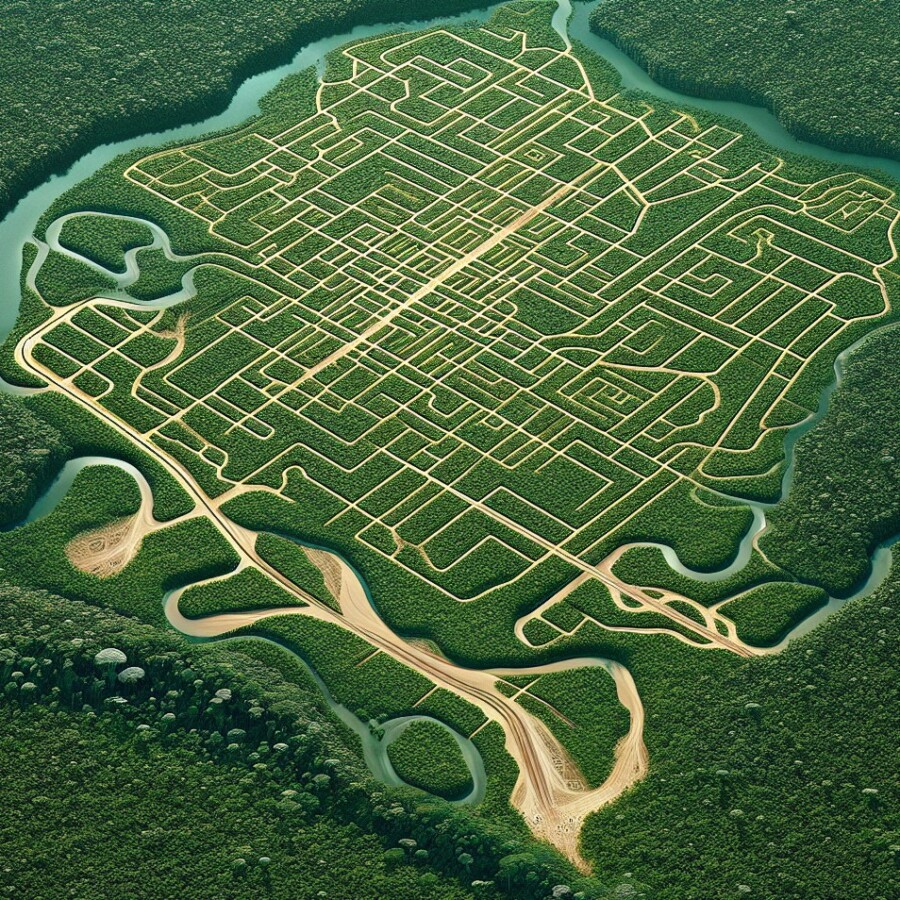A massive ancient city has been discovered in the Amazon rainforest, hidden for thousands of years by dense vegetation. This remarkable finding challenges our previous understanding of the history of human habitation in the Amazon. The city, located in the Upano area in eastern Ecuador, was connected by an extensive network of roads and canals. While cities in the highlands of South America, such as Machu Picchu in Peru, were already known, it was believed that people in the Amazon lived nomadically or in small settlements. This discovery proves that ancient people in the Amazon lived in complex urban societies.
The city was built around 2,500 years ago and was inhabited for approximately 1,000 years. The exact population size is difficult to determine, but scientists estimate it to be in the tens of thousands, if not hundreds of thousands. Using advanced LiDAR technology, archaeologists identified 6,000 rectangular platforms, believed to be the foundations of ancient homes and ceremonial structures. These platforms were arranged in groups around plazas, with a central platform. The city also had an intricate network of straight roads and paths, some extending up to 25km, which were a significant aspect of the research.
The road network is considered highly sophisticated, with right angles indicating careful planning and construction. The scientists believe that these roads held significant meaning, possibly related to ceremonies or beliefs. Additionally, the presence of causeways with ditches suggests the existence of canals to manage water resources in the region. The researchers also found evidence of threats to the city, such as blocked entrances and ditches, indicating possible conflicts with neighboring groups.
This comprehensive survey of the ancient city is the result of 25 years of research. The findings reveal a large and complex society, potentially even larger than the well-known Mayan societies in Mexico and Central America. The architecture, land use, and ceramics of this Amazonian civilization are distinct from other known civilizations, making it a unique discovery. Although much is still unknown about the people who lived there, artifacts such as pits, hearths, jars, and burnt seeds suggest a focus on agriculture, particularly the cultivation of maize and sweet potatoes.
This groundbreaking research challenges the belief that no ancient groups inhabited the Amazon. The discovery of this ancient city has opened up new possibilities for understanding the rich history and cultural diversity of the Amazon region. The next step for the researchers is to explore the adjoining area of 300 sq km that has not yet been surveyed, in order to further unravel the mysteries of this ancient civilization.
Original news source: Huge ancient lost city found in the Amazon (BBC)
🎧 Listen:
Slow
Normal
Fast
📖 Vocabulary:
| 1 | ancient | Belonging to a period of history that is very far back in time |
| 2 | habitation | The act of living in a place or occupying it |
| 3 | extensive | Covering a large area or scope; widespread |
| 4 | nomadically | Moving from place to place without a permanent home |
| 5 | urban | Related to or characteristic of a city or town |
| 6 | LiDAR | A remote sensing technology that measures distance by illuminating a target with laser light |
| 7 | ceremonial | Used or performed as part of a ritual or ceremony |
| 8 | sophisticated | Complex and highly developed, showing advanced skills or thought |
| 9 | causeways | Raised roads or tracks across low or wet ground |
| 10 | conflicts | Serious disagreements or arguments |
| 11 | comprehensive | Thorough and complete in coverage or scope |
| 12 | ceramics | Objects made from clay and hardened by heat |
| 13 | artifacts | Objects made by humans, typically an item of cultural or historical interest |
| 14 | cultivation | The process of growing plants in soil for food or other products |
| 15 | diversity | The state of being diverse; variety |
Group or Classroom Activities
Warm-up Activities:
– News Summary
Instructions: Divide the class into small groups and assign each group a section of the article to read. After reading, each group must work together to create a concise news summary of their section. Then, each group presents their summary to the class, and the class can discuss and compare the different summaries.
– Opinion Poll
Instructions: As a class, discuss the significance of the discovery of the ancient city in the Amazon. Then, divide the class into pairs or small groups and have them create a list of questions for an opinion poll. Each group should come up with at least five questions related to the topic. Once the questions are prepared, have the groups go around and interview other students in the class, collecting their opinions and recording the responses. After the interviews, the class can come together and share the results of the poll, discussing the different perspectives.
– Sketch It
Instructions: Divide the class into pairs. Give each pair a sheet of paper and a pen or pencil. One student in each pair must describe a specific aspect of the ancient city (e.g. the road network, the rectangular platforms, the canals) to their partner, who must then sketch what they hear. After a few minutes, the pairs can compare their sketches and discuss any differences or similarities. This activity helps students practice their listening, speaking, and descriptive skills.
– Vocabulary Pictionary
Instructions: Create a list of vocabulary words from the article (e.g. habitation, archaeologists, civilization). Divide the class into small groups and give each group a set of vocabulary words. Each group must take turns selecting a word and drawing a picture to represent the word. The other groups must then try to guess the word based on the drawing. This activity helps students practice their vocabulary and visual communication skills.
– Future Predictions
Instructions: As a class, discuss the implications of the discovery of the ancient city for our understanding of the history and cultural diversity of the Amazon region. Then, divide the class into pairs or small groups and have them brainstorm and share their predictions about what future research and discoveries in the Amazon might reveal. Each group should present their predictions to the class, and the class can have a discussion about the different ideas shared.
🤔 Comprehension Questions:
1. What was the previous understanding of human habitation in the Amazon?
2. What evidence did archaeologists use to estimate the population size of the ancient city?
3. How were the rectangular platforms arranged in the city?
4. What is significant about the road network in the ancient city?
5. What do blocked entrances and ditches suggest about the ancient city?
6. How long did it take for researchers to complete the comprehensive survey of the ancient city?
7. How does the architecture, land use, and ceramics of this Amazonian civilization differ from other known civilizations?
8. What is the next step for the researchers in studying this ancient civilization?
Go to answers ⇩
🎧✍️ Listen and Fill in the Gaps:
A massive ancient city has been (1)______ in the Amazon rainforest, hidden for (2)______ of years by dense vegetation. This remarkable finding challenges our previous understanding of the history of human habitation in the Amazon. The city, located in the Upano area in eastern (3)______, was connected by an extensive network of roads and canals. While cities in the highlands of South America, such as (4)______ Picchu in Peru, were already known, it was believed that people in the Amazon lived nomadically or in small settlements. This discovery proves that ancient people in the Amazon lived in complex urban societies.
The city was built around 2,500 years ago and was inhabited for approximately 1,000 years. The exact population size is difficult to determine, but scientists estimate it to be in the tens of thousands, if not hundreds of thousands. Using advanced LiDAR technology, archaeologists identified 6,000 rectangular platforms, (5)______ to be the foundations of ancient homes and ceremonial structures. These platforms were arranged in groups around plazas, with a central platform. The city also had an intricate network of straight roads and paths, some (6)______ up to 25km, which were a significant aspect of the research.
The road network is considered highly (7)______, with right angles indicating (8)______ planning and construction. The scientists believe that these roads held significant meaning, possibly related to ceremonies or beliefs. Additionally, the presence of causeways with ditches suggests the existence of canals to manage water resources in the region. The (9)______ers also found evidence of threats to the city, such as blocked entrances and ditches, indicating possible conflicts with (10)______ groups.
This comprehensive (11)______ of the ancient city is the result of 25 years of research. The findings reveal a large and complex society, potentially even larger than the well-known Mayan societies in Mexico and (12)______ America. The architecture, land use, and ceramics of this Amazonian civilization are distinct from other known civilizations, making it a unique (13)______. Although much is still unknown about the people who lived there, artifacts such as pits, hearths, jars, and burnt seeds suggest a (14)______ on agriculture, particularly the cultivation of maize and sweet potatoes.
This groundbreaking research challenges the belief that no ancient groups (15)______ the Amazon. The discovery of this ancient city has opened up new possibilities for understanding the rich history and cultural diversity of the Amazon region. The next step for the researchers is to explore the adjoining area of 300 sq km that has not yet been surveyed, in (16)______ to further unravel the mysteries of this ancient civilization.
Go to answers ⇩
💬 Discussion Questions:
Students can ask a partner these questions, or discuss them as a group.
1. What is your initial reaction to the discovery of a massive ancient city in the Amazon rainforest?
2. How would you feel if you were part of the team of archaeologists who made this remarkable finding?
3. Do you think it is surprising that the city in the Amazon was believed to be inhabited by nomadic or small settlements? Why or why not?
4. What do you think the presence of an extensive road network in the ancient city suggests about the society that lived there?
5. How do you think the discovery of this ancient city challenges our previous understanding of human habitation in the Amazon?
6. Do you like learning about ancient civilizations? Why or why not?
7. What do you think the significance of the right angles in the road network of the ancient city could be?
8. How would you feel if you were able to visit this ancient city and explore its ruins?
9. Do you think the discovery of this ancient city will change the way people view the Amazon region? Why or why not?
10. How do you think the presence of blocked entrances and ditches in the ancient city indicates possible conflicts with neighboring groups?
11. What do you think the focus on agriculture, particularly the cultivation of maize and sweet potatoes, suggests about the lifestyle of the people who lived in the ancient city?
12. How would you feel if you were able to uncover more artifacts and gain a deeper understanding of the ancient civilization in the Amazon?
13. Do you think the discovery of this ancient city will lead to more archaeological research in the Amazon rainforest? Why or why not?
14. What do you think the researchers hope to uncover in the adjoining area that has not yet been surveyed?
15. How do you think this discovery will impact our overall understanding of ancient civilizations?
Individual Activities
📖💭 Vocabulary Meanings:
Match each word to its meaning.
Words:
1. ancient
2. habitation
3. extensive
4. nomadically
5. urban
6. LiDAR
7. ceremonial
8. sophisticated
9. causeways
10. conflicts
11. comprehensive
12. ceramics
13. artifacts
14. cultivation
15. diversity
Meanings:
(A) Objects made from clay and hardened by heat
(B) A remote sensing technology that measures distance by illuminating a target with laser light
(C) Serious disagreements or arguments
(D) The process of growing plants in soil for food or other products
(E) Covering a large area or scope; widespread
(F) Used or performed as part of a ritual or ceremony
(G) Complex and highly developed, showing advanced skills or thought
(H) Related to or characteristic of a city or town
(I) The state of being diverse; variety
(J) The act of living in a place or occupying it
(K) Belonging to a period of history that is very far back in time
(L) Moving from place to place without a permanent home
(M) Objects made by humans, typically an item of cultural or historical interest
(N) Raised roads or tracks across low or wet ground
(O) Thorough and complete in coverage or scope
Go to answers ⇩
🔡 Multiple Choice Questions:
1. Where was the ancient city discovered?
(a) Andes Mountains
(b) Sahara Desert
(c) Great Barrier Reef
(d) Amazon rainforest
2. How long ago was the city built?
(a) 1,000 years ago
(b) 500 years ago
(c) 2,500 years ago
(d) 100 years ago
3. What technology did archaeologists use to identify the rectangular platforms?
(a) Satellite imagery
(b) LiDAR
(c) Ground-penetrating radar
(d) Sonar
4. How many rectangular platforms were identified?
(a) 6,000
(b) 1,000
(c) 10,000
(d) 100,000
5. What is the estimated population size of the city?
(a) Hundreds of thousands
(b) Millions
(c) Unknown
(d) Tens of thousands
6. What is significant about the road network in the city?
(a) It is made of gold
(b) It has right angles indicating careful planning and construction
(c) It extends up to 100 km
(d) It is made of stone
7. What evidence suggests possible conflicts with neighboring groups?
(a) Blocked entrances and ditches
(b) Ancient weapons
(c) Defensive walls
(d) Ancient writings
8. What is the focus of agriculture in the ancient city?
(a) Wheat and barley
(b) Rice and soybeans
(c) Maize and sweet potatoes
(d) Apples and oranges
Go to answers ⇩
🕵️ True or False Questions:
1. The city was connected by an extensive network of roads and canals.
2. Scientists estimate the population size to be in the tens or thousands, if not hundreds or thousands.
3. The discovery challenges previous understanding of human habitation in the Amazon.
4. The city was built around 2,500 years ago and inhabited for approximately 1,000 years.
5. It was believed that people in the Amazon lived sedentary or in large settlements.
6. The city was exposed for thousands of years by dense vegetation.
7. A massive ancient city has been discovered in the Amazon rainforest.
8. The discovery reveals a large and complex society, potentially larger than the Mayan societies in Mexico and Central America.
Go to answers ⇩
📝 Write a Summary:
Write a summary of this news article in two sentences.
Check your writing now with the best free AI for English writing!
Writing Questions:
Answer the following questions. Write as much as you can for each answer.
Check your answers with our free English writing assistant!
1. How does the discovery of the ancient city in the Amazon challenge previous understanding of human habitation in the region?
2. What evidence did archaeologists use to estimate the population size of the ancient city?
3. What features of the road network suggest careful planning and construction in the ancient city?
4. What evidence suggests that the ancient city may have faced conflicts with neighboring groups?
5. What artifacts were found in the ancient city that suggest a focus on agriculture?
✅ Answers
🤔✅ Comprehension Question Answers:
1. The previous understanding was that people in the Amazon lived nomadically or in small settlements.
2. Archaeologists used advanced LiDAR technology to identify 6,000 rectangular platforms, which they believe were the foundations of ancient homes and ceremonial structures, to estimate the population size.
3. The rectangular platforms were arranged in groups around plazas, with a central platform.
4. The road network in the ancient city is considered highly sophisticated, with right angles indicating careful planning and construction.
5. Blocked entrances and ditches suggest possible conflicts with neighboring groups.
6. It took researchers 25 years to complete the comprehensive survey of the ancient city.
7. The architecture, land use, and ceramics of this Amazonian civilization are distinct from other known civilizations.
8. The next step for the researchers is to explore the adjoining area of 300 sq km that has not yet been surveyed, in order to further unravel the mysteries of this ancient civilization.
Go back to questions ⇧
🎧✍️✅ Listen and Fill in the Gaps Answers:
(1) discovered
(2) thousands
(3) Ecuador
(4) Machu
(5) believed
(6) extending
(7) sophisticated
(8) careful
(9) research
(10) neighboring
(11) survey
(12) Central
(13) discovery
(14) focus
(15) inhabited
(16) order
Go back to questions ⇧
📖💭✅ Vocabulary Meanings Answers:
1. ancient
Answer: (K) Belonging to a period of history that is very far back in time
2. habitation
Answer: (J) The act of living in a place or occupying it
3. extensive
Answer: (E) Covering a large area or scope; widespread
4. nomadically
Answer: (L) Moving from place to place without a permanent home
5. urban
Answer: (H) Related to or characteristic of a city or town
6. LiDAR
Answer: (B) A remote sensing technology that measures distance by illuminating a target with laser light
7. ceremonial
Answer: (F) Used or performed as part of a ritual or ceremony
8. sophisticated
Answer: (G) Complex and highly developed, showing advanced skills or thought
9. causeways
Answer: (N) Raised roads or tracks across low or wet ground
10. conflicts
Answer: (C) Serious disagreements or arguments
11. comprehensive
Answer: (O) Thorough and complete in coverage or scope
12. ceramics
Answer: (A) Objects made from clay and hardened by heat
13. artifacts
Answer: (M) Objects made by humans, typically an item of cultural or historical interest
14. cultivation
Answer: (D) The process of growing plants in soil for food or other products
15. diversity
Answer: (I) The state of being diverse; variety
Go back to questions ⇧
🔡✅ Multiple Choice Answers:
1. Where was the ancient city discovered?
Answer: (d) Amazon rainforest
2. How long ago was the city built?
Answer: (c) 2,500 years ago
3. What technology did archaeologists use to identify the rectangular platforms?
Answer: (b) LiDAR
4. How many rectangular platforms were identified?
Answer: (a) 6,000
5. What is the estimated population size of the city?
Answer: (d) Tens of thousands
6. What is significant about the road network in the city?
Answer: (b) It has right angles indicating careful planning and construction
7. What evidence suggests possible conflicts with neighboring groups?
Answer: (a) Blocked entrances and ditches
8. What is the focus of agriculture in the ancient city?
Answer: (c) Maize and sweet potatoes
Go back to questions ⇧
🕵️✅ True or False Answers:
1. The city was connected by an extensive network of roads and canals. (Answer: True)
2. Scientists estimate the population size to be in the tens or thousands, if not hundreds or thousands. (Answer: False)
3. The discovery challenges previous understanding of human habitation in the Amazon. (Answer: True)
4. The city was built around 2,500 years ago and inhabited for approximately 1,000 years. (Answer: False)
5. It was believed that people in the Amazon lived sedentary or in large settlements. (Answer: False)
6. The city was exposed for thousands of years by dense vegetation. (Answer: False)
7. A massive ancient city has been discovered in the Amazon rainforest. (Answer: True)
8. The discovery reveals a large and complex society, potentially larger than the Mayan societies in Mexico and Central America. (Answer: True)
Go back to questions ⇧













